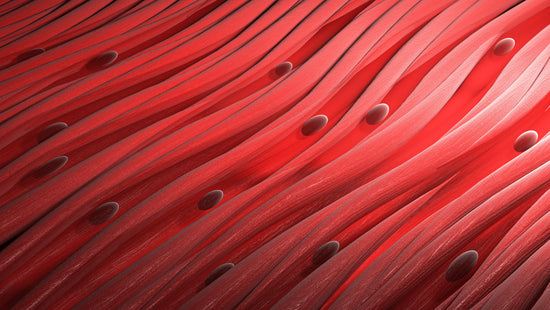How and Where the Body Makes Testosterone
Testosterone is a steroid hormone, synthesized naturally in both males and females. In males, testosterone is synthesized primarily in the Leydig cells of the testes, while in females it is made in the thecal cells of the ovary. The hormone can also be made, in lesser amounts, in the adrenal gland. Although muscular activity is known to boost testosterone production, the molecule is not actually made in the muscles themselves.
Testosterone synthesis and degradation is regulated by other hormones along the hypothalamic-pituitary-testicular axis in males. In short, in men, the brain directs the production of luteinizing hormone (LH), which directly controls the abundance of Leydig cells and their rate of testosterone synthesis. LH levels in turn are controlled by gonadotropin-releasing hormone, released by the hypothalamus. In the testes, LH stimulates enzymes that speed up the biochemical synthesis of testosterone per se. If the body senses that there is enough––or too much––testosterone, then the brain and the pituitary gland will stop making the signals that are needed for testosterone production in the sex organs.
The biochemical synthesis of testosterone ultimately starts with cholesterol. This molecule is converted into something known as dehydroepiandrosterone, or DHEA. At this point there are actually several ways to make testosterone, but in human males, the most common next step is that DHEA is converted into the direct precursor of testosterone, androstenedione. In the testes (or the ovaries in women), androstenedione, provided there is enough positive stimulation by LH, is made into testosterone.
The Roles That Testosterone Plays
Once made, testosterone enters the blood stream and plays key roles in myriad physiological functions, not only sexual activities but also in several metabolic processes including bone growth and neurological transmissions. Testosterone is one type of a general class of molecules called androgens. These exert their influence on the body by binding to the surfaces of target cells and stimulating responses inside the cells. For bone cells, for example, the binding of testosterone can stimulate ossification, which is the process of laying down new bone material. For nerve cells, a derivative of testosterone can bind to the GABA (gamma amino butyric acid) receptor, spurring the action of this important neurotransmitter.
Of course, testosterone plays an important role in sexual determination and sexual function. In the former case, during fetal development, the level of testosterone helps facilitate the creation of the cells of the testes, leading to male traits. In the latter case testosterone is a primary factor in one’s libido and erectile function. Although the specific mechanism of these actions are not completely understood, both are most likely mediated through androgen receptor binding of testosterone or its derivatives, as is the case for bone growth and neural response.
The Ingredients
KSM-66 Ashwagandha
Ashwagandha root (Withania somnifera) has long been known to stimulate testosterone production in males. This medicinal plant has been used in Ayurvedic medicine for over 6,000 years. Traditional medics in India used, and continue to use, Ashwagandha to treat low sperm count. Interestingly, one study that documented that Ashwagandha can enhance sperm count (by about 1.5-fold) and sperm motility (by about a 50% increase), also noted that testosterone levels went up in younger men (22–44 years old) by as much as 17% [1]. In this study, KSM-66 Ashwagandha was used, a formulation that ensured purity and a high content of withanolide glycosides, thought to be the active ingredient in Ashwagandha.
Another study focused on overweight males from 40–70 years old [2]. In that double-blind investigation, it was observed that ingesting about 20 mg of withanolide glycosides a day over eight weeks raised serum testosterone levels by 15%. This value was not only consistent with that in the first report (17%) but was statistically significant when compared to the placebo group. The authors of this 2013 analysis concluded with this statement, “The most consistent positive finding of the present study was that decreased fertility in males was ameliorated by Ashwagandha root extract as evidenced by an increase in sperm concentration, ejaculate volume, and motile sperm count and an increase in the serum levels of testosterone.” [2]
Testofen Fenugreek
Fenugreek, an annual plant in the family Fabaceae, has also been used in traditional medicine in India and other parts of the world. It has been attributed to several benefits when used with care, including an ability to enhance meaningful testosterone levels. In a double-blind clinical trial, scientists found that one particular formulation of fenugreek called Testofen® did raise T levels and improved male sexual function [3]. In this 2015 trial, participants (120 healthy men between 43 and 70) took seed extracts at 600 mg per day over a 12-week period, and their benefits in these respects were found to be statistically significant compared to the placebo group.
Other positive outcomes of fenugreek supplementation have been advanced, such as a treatment for diabetes, high cholesterol, menstrual cramps, and obesity, but the scientific evidence for these benefits is not as well established as that for testosterone. Fenugreek is also used with the goal of enhancing energy and increasing muscle strength/mass, and to generally improve one’s overall quality of life. In establishing a basis for these benefits, typically daily supplementation at a rate of 300–600 mg has been used.
Tribulus
Tribulus terrestris is a dicotyledonous herbal plant in the family Zygophyllaceae. Extracts of this plant are well documented to promote health gains such as athletic performance, tissue damage repair, aphrodisiac effects, and erectile dysfunction (ED). Of interest is that the data seems to indicate that the means by which these benefits are derived is not an increase in testosterone, but through some other mechanism.
One group of scientists examined a large number of investigations [4] and concluded that Tribulus may impart its effect through the release of nitric oxide (NO), a chemical that relaxes smooth muscle and is thus critical for blood flow to the tissues. Another study, done in 2017 on 180 men between 18–65 years old having mild or moderate ED, examined how well Bulgarian Tribulus affected their sexual health [5]. Here, roughly 125 mg of Tribulus was administered orally in a double-blind format. After 12 weeks, the results were clear that there were no negative side effects, but there was a significant (P < 0.05) improvement in four measures: sexual desire, intercourse satisfaction, orgasm function, and overall satisfaction. A third study focused on trained athletes. In this investigation, a Chinese team administered Tribulus to male boxers over 11 weeks during high-intensity training [6]. They concluded that Tribulus did not change muscle mass and plasma levels of testosterone but that raised levels of an insulin growth factor binding protein significantly alleviated muscle damage and promoted the anaerobic performance of the boxers.
Longjack
Eurycoma longifolia (longjack, also called tongkat ali or Malaysian ginseng) is a popular traditional herbal medicine, and is a flowering plant of the family Simaroubaceae, native to southeast Asia. The energy boost that one gets after taking longjack could be a result of a number of different chemical effects, and a testosterone boost certainly could be among these.
Scientists have performed several controlled studies on the influence of tongkat ali on health, particularly on its putative anti-aging properties for men. The consensus from these reports is that Eurycoma longifolia extracts have a clear benefit for those seeking to experience heightened levels of testosterone, improved muscle strength, and sexual performance. Considering the first of these, one study found that while the levels of the free testosterone increased significantly after a two-week trial with 600 mg of Eurycoma longifolia extract, the mechanism was through adrenal production rather than in the testes [7].
Similarly, another study found significant boosts in testosterone in senior men, although not in women after ingesting 400 mg per day of longjack extract for 5 weeks [8]. Naturally, it is of interest to see how well longjack works in terms of direct sexual function, not only in testosterone levels. Thus, a recent (2021) study out of Brazil examined the effects of Eurycoma longifolia supplementation on ED [9]. This 6-month randomized, double-blind, and placebo-controlled survey discovered that 200 mg of the herb significantly improved the erectile function of men about 50 years old, but that the effect was far more demonstrable when coordinated with physical training.
EGCG
Epigallocatechin gallate (EGCG) is a flavonoid compound found in green tea. This substance, sometimes called Teavigo, is widely believed to stimulate fat metabolism and provide a boost to one’s overall energy level. A broad survey of the literature confirmed the ability of EGCG to promote fat oxidation and energy expenditure levels [10].
One study in particular revealed the benefits of ECGC for overweight post-menopausal women [11]. An Australian group of researchers found that 12 weeks of 150 mg of Teavigo, combined with a modest amount of walking, resulted in clear gains in blood pressure, heart rate, arterial function, and blood concentrations of lipids, glucose, and insulin. Remarkably, ECGC also seems to improve cognitive function; electroencephalogram monitoring of brain activity revealed boosts after as little as two hours following ingestion of 300 mg of ECGC, compared to placebo controls [12].
Zinc
This little ion is well known to biochemists who realize its critical role in enzyme function and metabolism. And in recent years zinc supplementation has been often promoted as virtual shot-on-the-arm a to one’s immune system.
But zinc role in enhancing testosterone level is increasingly coming into view, although the connection was made more than 40 years ago. It was noticed in 1981 that zinc additions to the diet improved both sperm count and plasma testosterone levels [13]. And a 1996 study out of Wayne State University showed that zinc supplementation for six months gave a noticeable increase in serum testosterone levels in men who were otherwise healthy [14]. These days the evidence for a “zinc-link” to men’s health is clear; in a 2020 report the authors stated upfront that, “Zinc has important biological actions insofar as the male reproductive physiology and endocrine system” [15].
Magnesium
Another ion that is absolutely critical in biochemistry is magnesium. Even smaller than zinc, magnesium’s body wide influence extends from primary sugar metabolism to maintaining the proper shape and function of DNA and RNA.
Given its ubiquity in molecular processes, it is not a surprise that magnesium supplementation can help in many scenarios of hormone imbalance. A study done back in 2011 showed that 4 weeks of adding 10 mg per kilogram of body weight boosted the free plasma levels of testosterone in athletes [16]. And an Italian study done the same year [17] noticed a significant correlation between magnesium and testosterone levels in nearly 400 men whose mean age was 74. The bottom line? There is a body of evidence that reveals that, at least in men, magnesium exerts a positive influence on anabolic hormonal status, including testosterone [18].
Vitamin D
Once made in the body from nutrients you get from your diet and sunlight, Vitamin D circulates in the blood to regulate many physiological functions. Bone, skin, and teeth health are clearly linked to Vitamin D. But one of these functions seems to be testosterone synthesis. In 2010 a large clinical trial compared two groups of men, one that received vitamin D supplements, and one that only received a placebo. The treatment group experienced a highly significant increase (of about 30%) in testosterone after 6–12 months of vitamin D supplementation [19].
When the large number of studies that have focused on the connection between Vitamin D and testosterone were examined last year in 2021, the overall consensus seems to be that there is a slight, but positive relationship between the two [20]. Moreover, recently there appears to be evidence that vitamin D taken in conjunction with zinc offers additional benefits vis-à-vis testosterone production, although more research is needed on this issue.
References
- Ambiye VR, et al. (2013). Clinical evaluation of the spermatogenic activity of the root extract of Ashwagandha (Withania somnifera) in oligospermic males: A pilot study. Evid Based Complement Alternat Med. 2013: 571420. doi: 10.1155/2013/571420.
- Lopresti AL, Drummond PD, & Smith SJ (2019). A randomized, double-blind, placebo-controlled, crossover study examining the hormonal and vitality effects of Ashwagandha (Withania somnifera) in aging, overweight males. Am J Mens Health 13(2): 1557988319835985. doi: 10.1177/1557988319835985.
- Rao A, et al. (2016). Testofen, a specialised Trigonella foenum – graecum seed extract reduced age-related symptioms of androgen decrease, increases testosterone levels and improves sexual function in healthy aging males in a double-blind randomised clinical study. Aging Male, 19(2): 134–142.
- Qureshi A, Naughton DP, & Petroczi A (2014). A systematic review on the herbal extract Tribulus terrestris and the roots of its putative aphrodisiac and performance enhancing effect. J Diet Suppl. 11(1): 64-79. doi: 10.3109/19390211.2014.887602.
- Kamenov Z, et al. (2017). Evaluation of the efficacy and safety of Tribulus terrestris in male sexual dysfunction: A prospective, randomized, double-blind, placebo-controlled clinical trial. Maturitas 99: 20–26. doi: 10.1016/j.maturitas.2017.01.011.
- Ma Y, Guo Z, & Wang X (2017). Tribulus terrestris extracts alleviate muscle damage and promote anaerobic performance of trained male boxers and its mechanisms: Roles of androgen, IGF-1, and IGF binding protein-3. J Sport Health Sci. 6(4): 474–481. doi: 10.1016/j.jshs.2015.12.003.
- Chan KQ, et al. (2021). The effect of Eurycoma Longifolia on the regulation of reproductive hormones in young males. Andrologia 53(4): e14001. doi: 10.1111/and.14001.
- Henkel RR, et al. (2014). Tongkat Ali as a potential herbal supplement for physically active male and female seniors: a pilot study. Phytother Res. 28(4): 544–550. doi: 10.1002/ptr.5017.
- Leitão AE, et al. (2021). A 6-month, double-blind, placebo-controlled, randomized trial to evaluate the effect of Eurycoma longifolia (Tongkat Ali) and concurrent training on erectile function and testosterone levels in androgen deficiency of aging males (ADAM). Maturitas 145: 78–85.
- Kapoor MP, et al. (2017). Physiological effects of epigallocatechin-3-gallate (EGCG) on energy expenditure for prospective fat oxidation in humans: A systematic review and meta-analysis. J Nutr Biochem. 43: 1-10. doi: 10.1016/j.jnutbio.2016.10.013.
- Hill AM, et al. (2007). Can EGCG reduce abdominal fat in obese subjects? J Am Coll Nutr. 26(4): 396S-402S. doi: 10.1080/07315724.2007.10719628.
- 12. Scholey A, et al. (2012). Acute neurocognitive effects of epigallocatechin gallate (EGCG). Appetite 58(2): 767–770. doi: 10.1016/j.appet.2011.11.016.
- Netter A, Hartoma R, & Nahoul K (1981). Effect of zinc administration on plasma testosterone, dihydrotestosterone, and sperm count. Arch Androl. 7(1): 69–73. doi: 10.3109/01485018109009378.
- Prasad AS, et al. (1996). Zinc status and serum testosterone levels of healthy adults. Nutrition 12(5): 344-8. doi: 10.1016/s0899-9007(96)80058-x.
- Santos HO & Teixeira FJ (2020). Use of medicinal doses of zinc as a safe and efficient coadjutant in the treatment of male hypogonadism. Aging Male 23(5): 669–678. doi: 10.1080/13685538.2019.1573220.
- Cinar V, et al. (2011). Effects of magnesium supplementation on testosterone levels of athletes and sedentary subjects at rest and after exhaustion. Biol Trace Elem Res. 140(1): 18–23. doi: 10.1007/s12011-010-8676-3.
- Maggio M, et al. (2011). Magnesium and anabolic hormones in older men. Int J Androl. 34(6 Pt 2): e594-600. doi: 10.1111/j.1365-2605.2011.01193.x.
- Maggio M, et al. (2014). The interplay between magnesium and testosterone in modulating physical function in men. Int J Endocrinol. 2014: 525249. doi: 10.1155/2014/525249.
- Pilz S, et al. (2011). Effect of vitamin D supplementation on testosterone levels in men. Hormone and Metabolism Research 43: 223–225.
- D'Andrea S, et al. (2021). Relationship of Vitamin D status with testosterone levels: a systematic review and meta-analysis. Endocrine 72(1): 49–61. doi: 10.1007/s12020-020-02482-3.




